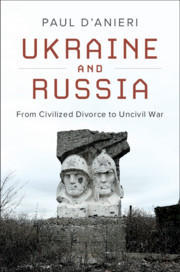Book contents
- Ukraine and Russia
- Ukraine and Russia
- Copyright page
- Dedication
- Contents
- Maps
- Tables
- Acknowledgments
- Additional material
- 1 The Sources of Conflict over Ukraine
- 2 New World Order? 1989‒1993
- 3 Hope and Hardship, 1994‒1999
- 4 Autocracy and Revolution, 1999‒2004
- 5 Reform and Reversal, 2004‒2010
- 6 Viktor Yanukovych and the Path to Confrontation, 2010‒2013
- 7 From Revolution to War, 2013‒2015
- 8 Conclusion: Ukraine, Russia, and the West ‒ from Cold War to Cold War
- Index
2 - New World Order? 1989‒1993
Published online by Cambridge University Press: 01 November 2019
- Ukraine and Russia
- Ukraine and Russia
- Copyright page
- Dedication
- Contents
- Maps
- Tables
- Acknowledgments
- Additional material
- 1 The Sources of Conflict over Ukraine
- 2 New World Order? 1989‒1993
- 3 Hope and Hardship, 1994‒1999
- 4 Autocracy and Revolution, 1999‒2004
- 5 Reform and Reversal, 2004‒2010
- 6 Viktor Yanukovych and the Path to Confrontation, 2010‒2013
- 7 From Revolution to War, 2013‒2015
- 8 Conclusion: Ukraine, Russia, and the West ‒ from Cold War to Cold War
- Index
Summary
As communism collapsed, disagreements emerged that endured until 2014. Russia struggled unsuccessfully to keep Ukraine in a new Moscow-led union and disagreement over the Black Sea Fleet and its base in Crimea proved unresolvable. Meanwhile, Russia and the West advanced different visions for post-Cold War Europe. Pressured by both Russia and the United States, Ukraine agreed to surrender its nuclear weapons in return for security assurances. Already in 1993, the prospect that a “red-brown” coalition of communists and fascists would come to power in Moscow prompted many countries to look for ways to guard against Russian reassertion, exacerbating the security dilemma.
Keywords
- Type
- Chapter
- Information
- Ukraine and RussiaFrom Civilied Divorce to Uncivil War, pp. 27 - 64Publisher: Cambridge University PressPrint publication year: 2019

